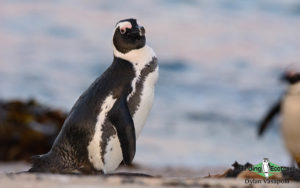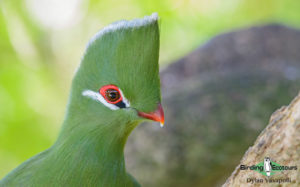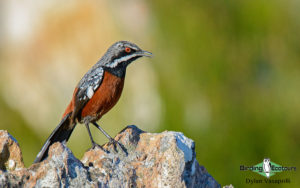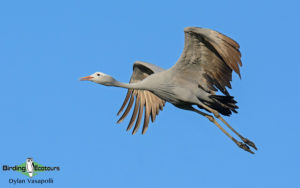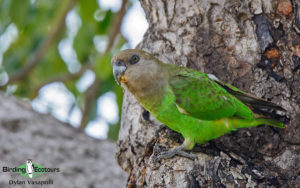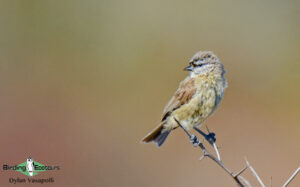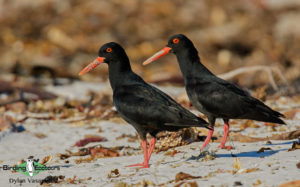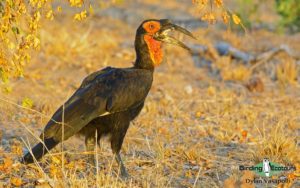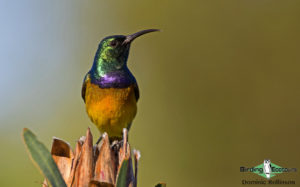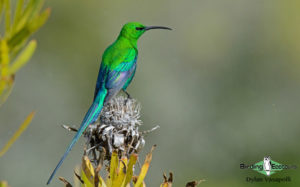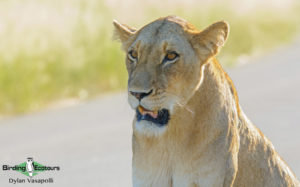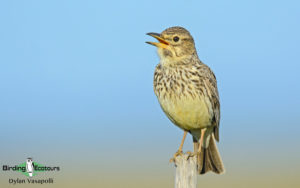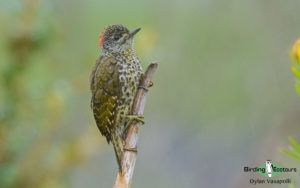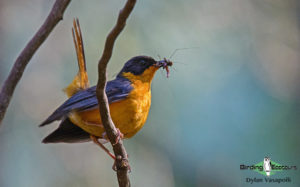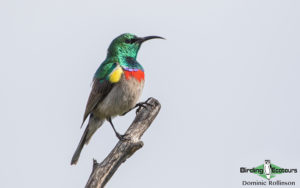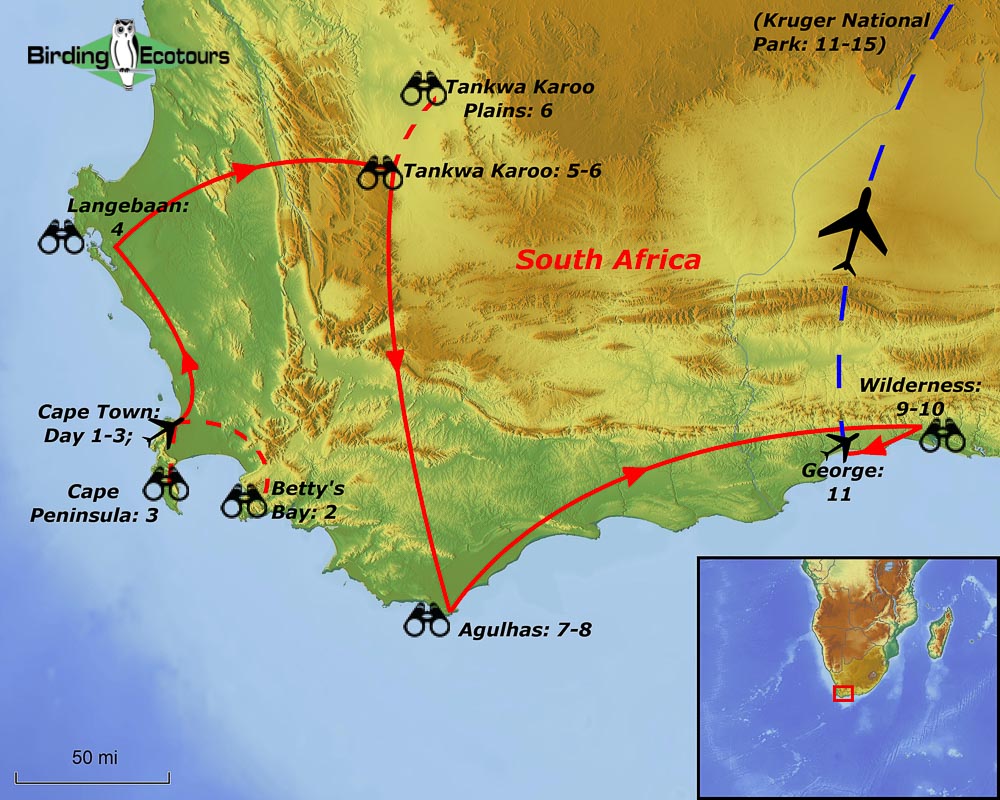South Africa Birding and Photo Tour – Cape to Kruger National Park
Go to: South Africa birding tours | Birding tours in Africa | Photo tours | All our birding tours
South Africa Birding and Photo Tour – Cape to Kruger National Park
January 2026
South Africa’s Western Cape Province is stunningly beautiful and hugely varied – from rocky sea cliffs and impressive mountains rising from the sea, to moist temperate forests, semi-desert, peaceful lakes, and a great deal more. On this tour we will introduce you to the diverse habitats (and hence bird species) of the Western Cape Province and spend a few days in the world-renowned Kruger National Park which is bustling with tropical bird species and other charismatic wildlife.
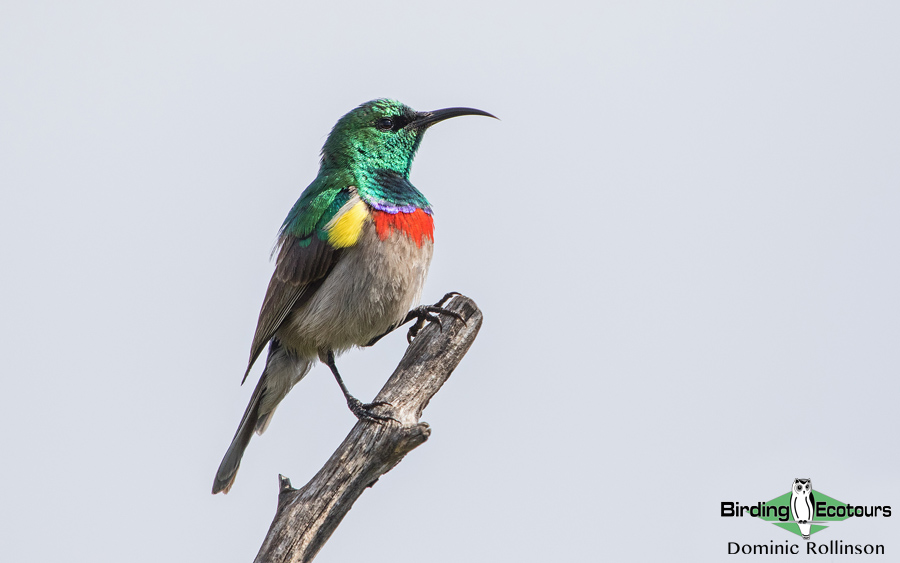
Our photography tours are essentially run as slower-paced birding tours that allow more time for photographing birds and animals, rather than heading off to tick the next species. Once we have found our target birds/animals, the idea is to then spend more time ensuring we get the perfect angle and light on our subjects until you are satisfied with your shots. We are unlikely to spend hours and hours waiting to photograph a particular species but will rather ensure we have adequate time to photograph each new species that we find.
We begin our South Africa birding and photo tour in the Garden Route – an idyllic area of green forests and beautiful lakes that you truly will not want to leave. Here, we’ll probably find the jewel-like Half-collared Kingfisher, the gorgeous (there is no better word for it) Knysna Turaco with its green body and scarlet wings, and a rich diversity of other birds – plus some nice mammals, as always. You could spend two weeks just here, photographing birds and other wildlife and of course the stunning scenery.
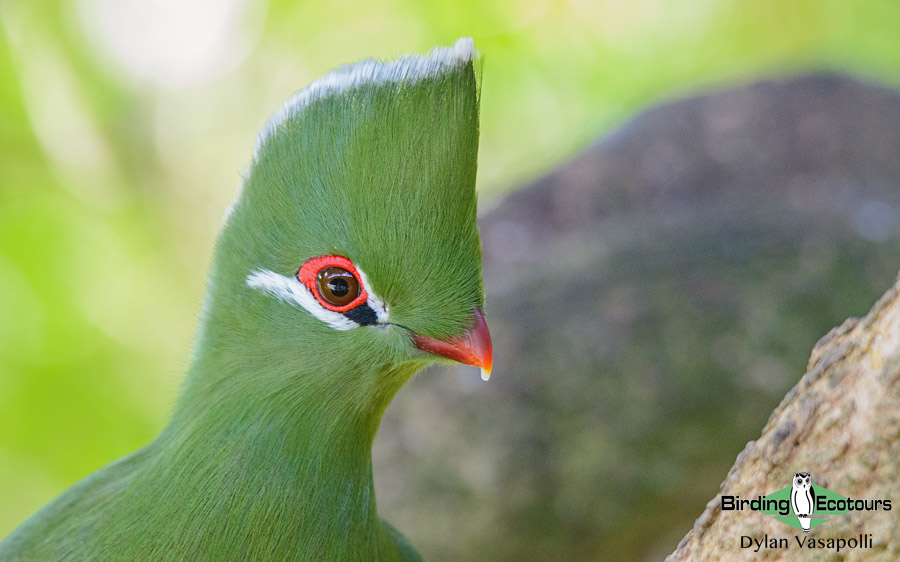
Moving from the Garden Route into the Agulhas Plains, we have a great chance at finding the fine-looking (Cape) Mountain Zebra, the striking Bontebok, and many wondrous birds such as Secretarybird, White Stork, Denham’s Bustard, loads of Blue Cranes (South Africa’s stunning national bird), some localized endemics such as Agulhas Long-billed Lark, Cape Clapper Lark, Southern Tchagra, Knysna Woodpecker and, as always, loads more.
After crossing the imposing Cape Fold Mountains, we then head inland to the Karoo semi-desert. This area has many endemics and we will look for and try to photograph various larks, Black-headed Canary and other canaries, Karoo Korhaan, Ludwig’s Bustard, and many of the others. There is also a chance of encountering some great mammals, which could even include something rare like a Caracal or Aardvark (both these require a huge dose of luck).
Eventually we head back to the coast – but this time the west coast. In the West Coast National Park and other great sites, we hope to encounter Common Ostrich, Black Harrier, Southern Black Korhaan, Cape Penduline Tit, Grey-winged Francolin, and other stunning (and often very localized) birds. We will also look for new mammals, such as the west coast endemic Heaviside’s Dolphin, the strange Rock Hyrax (which looks like a large rodent but is more closely related to elephants), and others.
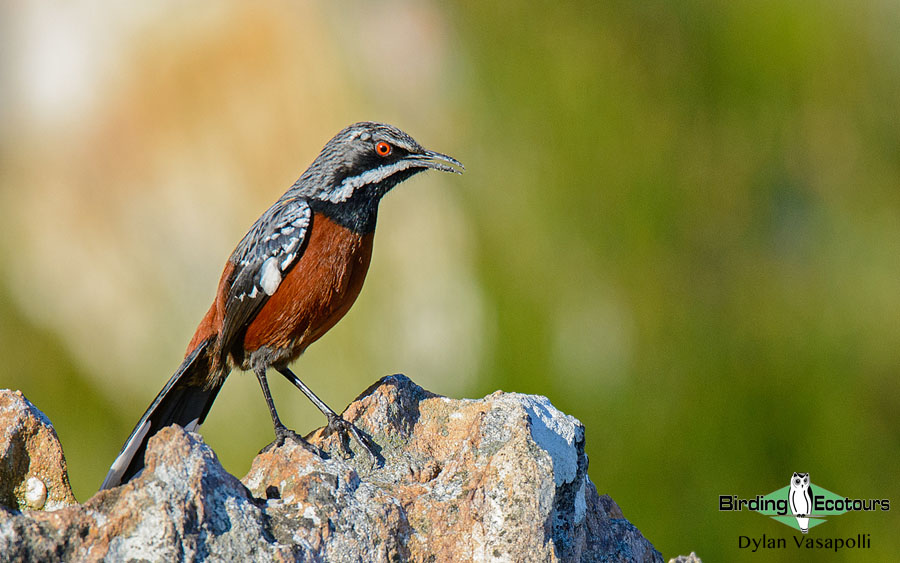
We then end the Cape leg of the tour in one of the world’s most scenically spectacular cities, Cape Town. The growth of this city is constrained by imposing geographical features – Table Mountain, the Cape of Good Hope, and of course the sea – the whole of Cape Town is on a stunning-looking peninsula that was once an island. The Cape Peninsula is full of localized endemics restricted to the world’s most plant-diverse floral kingdom, the fynbos biome (which has more plant species per unit area than even the Amazon). Some of these endemic birds restricted to the fynbos biome are dazzling; they include the likes of Orange-breasted Sunbird, Southern Double-collared Sunbird, Cape Sugarbird with its incredibly long tail, and many others. The nearby False Bay coast hosts one of the Cape’s most sought-after birds, the charismatic Cape Rockjumper – along with Cape Rock Thrush, Sentinel Rock Thrush, Ground Woodpecker, and many others. We’ll also look for seabirds, such as African Penguin, Cape Gannet, and more.
From Cape Town, we fly to the Kruger Mpumalanga International Airport, and begin the second part of this exciting photo trip. Here we spend five days at one of Africa’s greatest game parks, the Kruger National Park. We have a good chance of photographing the “Big Five” as well as a host of other, smaller mammals. Kruger is one of the richest national parks for mammals on the entire African continent. What’s more, it also has over 500 bird species, most of which are extremely easy to see in the dry woodlands and savanna – you will see multiple species of brightly colored and spectacular rollers, bee-eaters, storks, eagles, vultures, hornbills, and more.
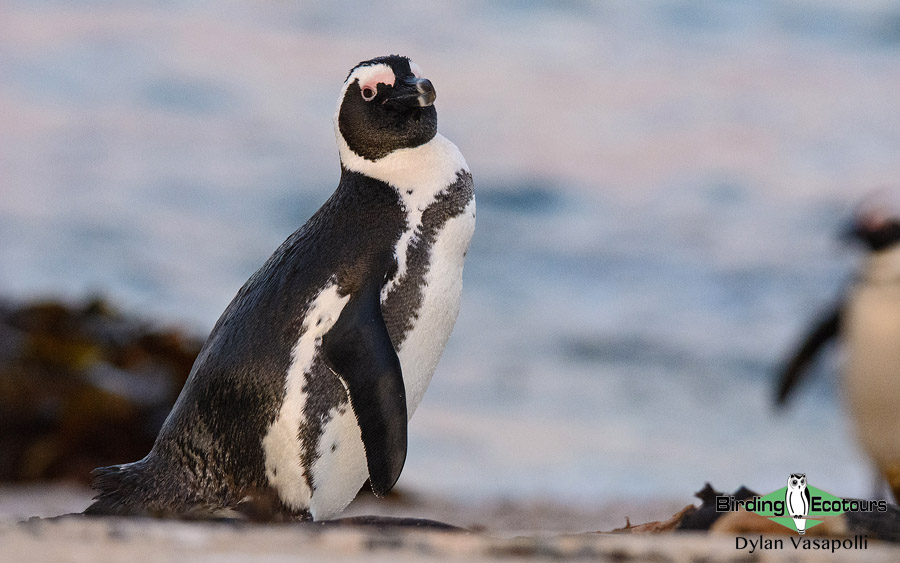
Itinerary (15 days/14 nights)
Day 1. Garden Route
Depending on arrival times today, we should have time this afternoon to visit one of the many wetlands in the area, where we could find African Snipe, African Fish Eagle, Malachite and Pied Kingfishers, and other waterbird species. We may also see small groups of Red-necked Spurfowls feeding on the roadside.
Overnight: Reflections Eco-Reserve, Wilderness (or similar)
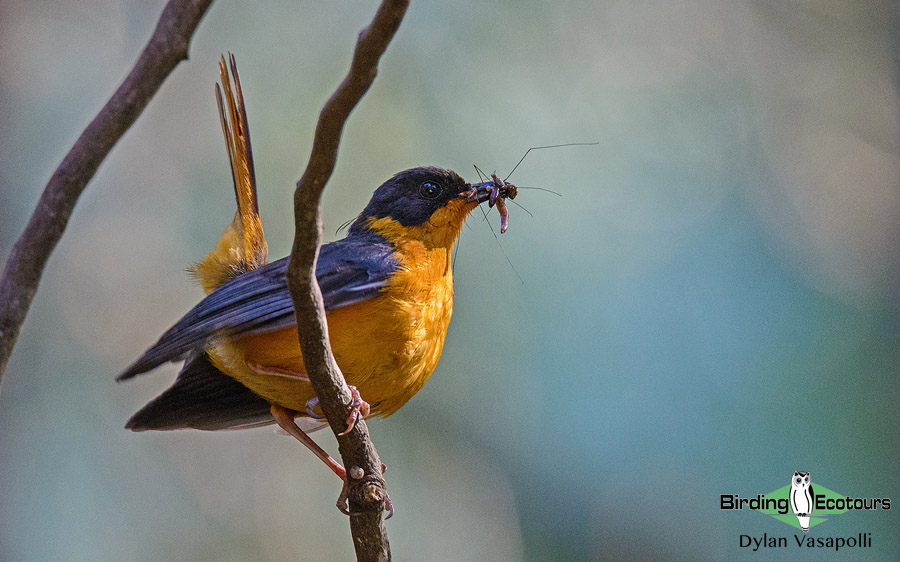
Day 2. Garden Route
Today we will spend time among the various wetlands and forests in the Wilderness area. We will probably start the day at a few wetlands, where we may get lucky with sightings of the elusive duo of Red-chested Flufftail and African Rail. We will then walk a few trails through beautiful forest along the Touws River. This will be our first bit of true forest birding on the trip, and there should be many new birds to find. The skulking Knysna Warbler will be searched for in thick tangles of undergrowth, while we could even get incredibly lucky with a sighting of Buff-spotted Flufftail, although it puts Knysna Warbler to shame with its ability to remain hidden. Other forest species to look out for include Knysna Woodpecker, Black-headed Oriole, Chorister Robin-Chat, White-starred Robin, Terrestrial Brownbul, Yellow-throated Woodland Warbler, Blue-mantled Crested Flycatcher, Narina Trogon, African Emerald Cuckoo, Black-bellied Starling, Green Wood Hoopoe, Scaly-throated Honeyguide, Grey Cuckooshrike, Grey and Greater Double-collared Sunbirds, and possibly the most beautiful of them all, Knysna Turaco. In the evenings we may get lucky with sightings of African Wood Owl.
Overnight: Reflections Eco-Reserve, Wilderness (or similar)
Day 3. Agulhas Plains
We’ll take advantage of the morning light to try to improve on photos from the last couple of days before we drive (roughly three hours) west to the plains and farmlands of the Agulhas region. En route we will keep a lookout for Forest Buzzard, which is sometimes seen perched on roadside pylons. Then we will spend some time birding the wheat fields in the Agulhas area, which are good areas for Denham’s Bustard, Karoo Korhaan, Cape Crow, Agulhas Long-billed Lark, and Blue Crane (usually in large numbers).
Overnight: De Hoop Collection, De Hoop National Park
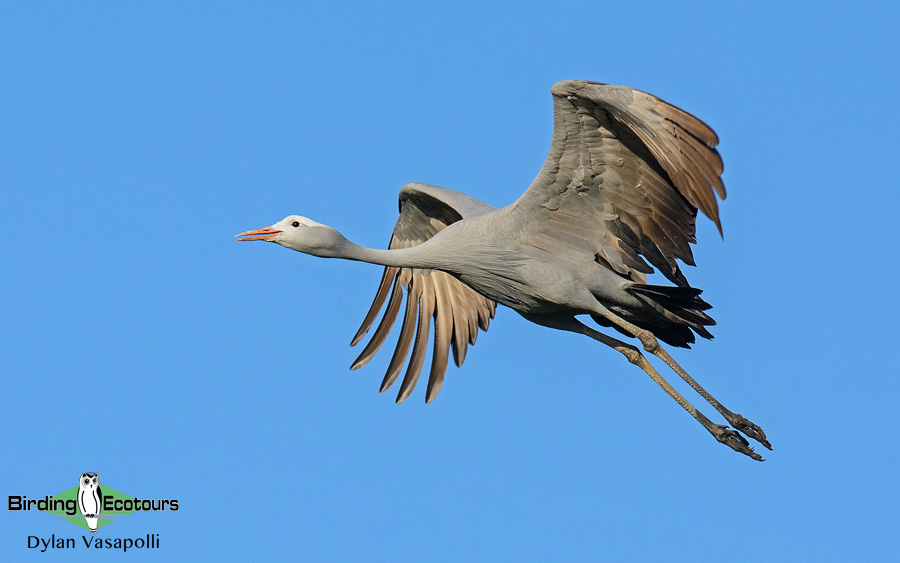
Day 4. Agulhas Plains
Today we will explore the beautiful De Hoop Nature Reserve, which has good numbers of antelope and some great birding too. Common Eland, Bontebok, and (Cape) Mountain Zebra are normally seen easily and can be quite confiding. Top birds to look out for include Agulhas Long-billed Lark, Southern Tchagra, Knysna Woodpecker, Secretarybird, and Black Cuckooshrike. The birds around the accommodation in De Hoop are often quite tame, providing excellent photographic opportunities. We may also get views of Cape Vulture, which have a large breeding colony nearby.
Overnight: De Hoop Collection, De Hoop National Park
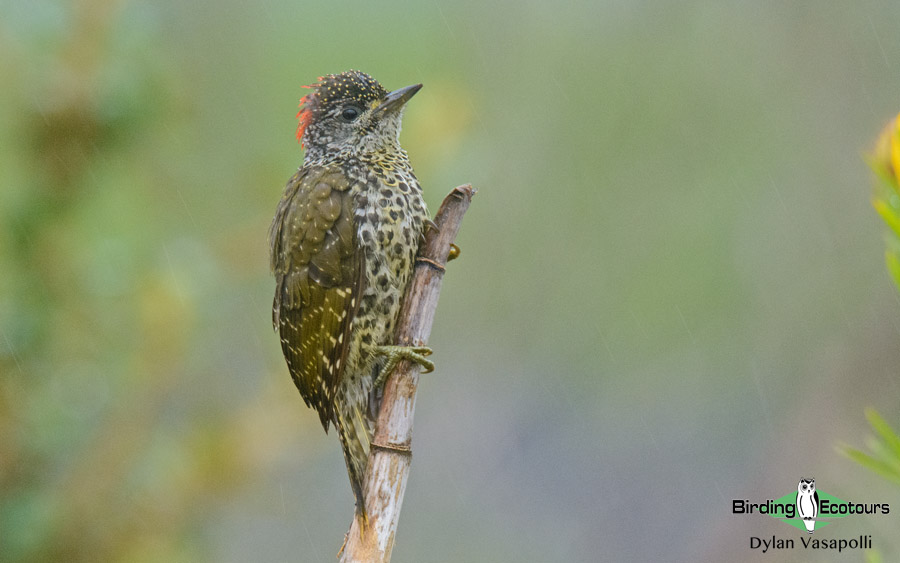
Day 5. Agulhas Plain and Tankwa Karoo
We’ll, once again, make the most of the morning light to try improve on photos from the last couple of days in Agulhas before heading inland (roughly 3.5 hours) through some spectacular mountain passes and eventually dropping back down into the vast, dry plains of the Tankwa Karoo, where we will be based for the next two nights. We will keep a lookout for Ground Woodpecker and Verreaux’s Eagle during the drive, and may have our first looks at Karoo specials such as Karoo Chat, Lark-like Bunting and Fairy Flycatcher in the afternoon near our accommodation.
Overnight: Tankwa Karoo/similar
Day 6. Tankwa Karoo
The Tankwa Karoo is an endemism hotspot with many of the species we will encounter here being restricted to these endless and seemingly barren plains. Looks, however, can certainly be deceiving, as we will spend the day hunting down many of these Karoo-adapted specials. The open plains will be searched for Karoo Korhaan, Karoo Eremomela, Burchell’s Courser (scarce and nomadic), Namaqua Sandgrouse, Greater Kestrel, Tractrac and Karoo Chats, Rufous-eared Warbler, and a host of lark species including Karoo, Spike-heeled, Large-billed, and Red-capped Larks. In the dry riverbeds, we should be able to find Namaqua Warbler, Fairy Flycatcher, Pririt Batis, Dusky Sunbird, and Acacia Pied Barbet.
We will also spend some time exploring rocky outcrops, where Cinnamon-breasted Warbler will be our primary target along with Grey Tit, Layard’s Warbler, Pale-winged Starling, and perhaps even Black-headed Canary. In the evening we will take a night drive to look for Freckled and Rufous-cheeked Nightjars and perhaps some of the Karoo’s rarer nocturnal mammals.
Overnight: Tankwa Karoo/similar.
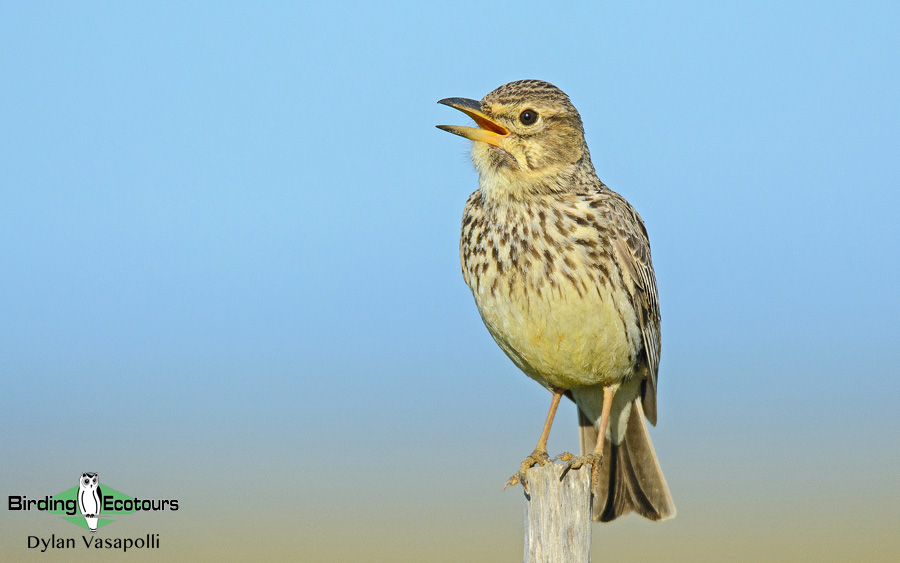
Day 7. Tankwa Karoo and West Coast National Park
After some early-morning birding in the Tankwa Karoo we will leave the dry plains and head towards the west coast, where we will have one night before continuing south to Cape Town. The drive (approximately three hours) is another picturesque one as we make our way through the Cape Fold Mountains, and then through vast areas of farmland.
After arriving at Langebaan around midday, we will explore the farmlands to the north in the afternoon. Some of the specials we’ll look for here include Blue Crane, Namaqua Sandgrouse, Acacia Pied Barbet, Cape Long-billed and Large-billed Larks, Grey-backed Sparrow-Lark, Sickle-winged and Ant-eating Chat, and perhaps Lanner Falcon.
After birding the farmlands, we will stop at a nearby salt works where we will enjoy close views of the dashing Chestnut-banded Plover as well as Lesser and Greater Flamingos, Black-necked Grebe, Red-necked Phalarope, and other shorebirds.
Before checking into our accommodation in Langebaan, we should have time to look for the resident pair of Verreaux’s Eagles just outside of town (if we run out of time today, we will ensure that we try the next morning).
Overnight: Le Mahi Guest House, Langebaan
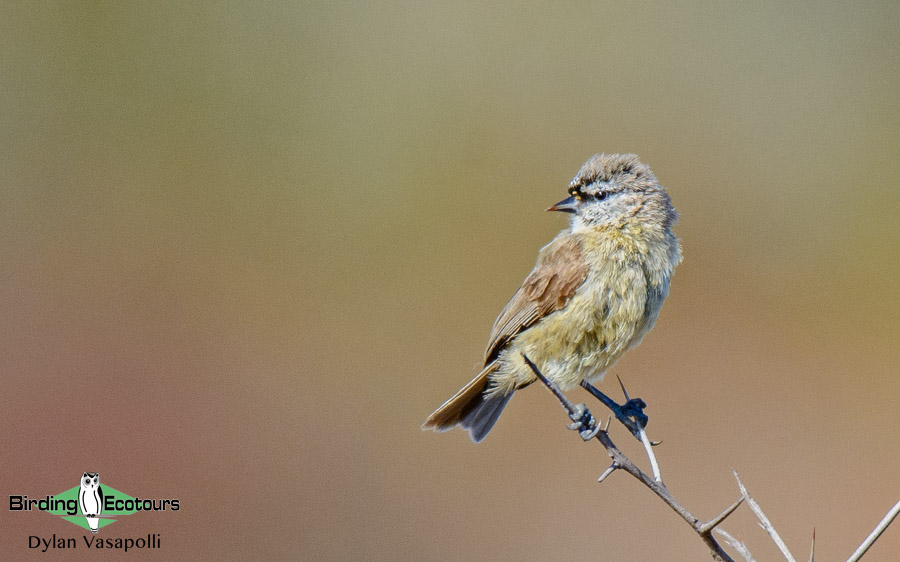
Day 8. West coast and Cape Peninsula
This morning we will explore the scenic West Coast National Park. We will try to time it right so that we arrive at the Langebaan Lagoon at a time when the shorebirds are close to the various hides on the lagoon. Here we can expect to see thousands of Palearctic shorebirds, which feed here throughout the Austral summer. Species to look for include Bar-tailed Godwit, Eurasian Curlew, Eurasian Whimbrel, Common Greenshank, Marsh Sandpiper, Grey and Common Ringed Plovers, Red Knot, Ruddy Turnstone, Curlew Sandpiper, Little Stint, and occasionally Terek Sandpiper. Of the resident shorebirds we should find White-fronted, Kittlitz’s, Three-banded, and Chestnut-banded Plovers.
The strandveld throughout the park will be explored for Grey Tit, Long-billed Crombec, Chestnut-vented Warbler, White-backed Mousebird, Bokmakierie, Cape Penduline Tit, Grey-winged Francolin, Cape Weaver, and our most important target, the graceful Black Harrier.
Upon leaving Langebaan and heading south towards Cape Town, we’ll fit in some final farmland birding. Hopefully Blue Cranes will pose for us while European Bee-eaters, near their small colony near Darling, are often a little more edgy. We’ll search the adjacent strandveld for Cape Clapper Lark, Grey-backed Cisticola, Southern Black Korhaan, Chestnut-vented Warbler, Cloud Cisticola, and Pearl-breasted Swallow. The wheat fields are normally alive with birds, and we can expect to also find Pied Starling, Yellow Canary, African Hoopoe, Red-capped Lark, and Capped Wheatear.
Upon arriving in Cape Town, we should have time to enjoy some late-afternoon photography in the golden light, with Table Mountain as our backdrop. We will likely be able to find some of the more common endemic species, which may include the likes of Southern Boubou, Cape Robin-Chat, Karoo Prinia and Southern Double-collared Sunbird.
Overnight: Fernwood Manor, Newlands (or similar)
Day 9. Hottentots Holland and False Bay
Today we will spend the day to the east of Cape Town in the Hottentots Holland Mountains, where we will be targeting several Cape endemics. The drive to our destination is a spectacular one; the route straddles the False Bay coastline, with dramatic fold mountains on the opposite side. During the drive we may get lucky with sightings of whales in False Bay, such as Bryde’s Whales. Our first stop will be at the quaint coastal town of Rooi Els, where we will search the rocky mountain slopes for Cape Rockjumper. Other important birds to look for on the slopes include Cape and Sentinel Rock Thrushes, Cape Siskin, Ground Woodpecker, and perhaps Verreaux’s Eagle overhead. The thicker fynbos nearby will be searched for Cape Sugarbird (frequently posing on top of Protea flowers), Orange-breasted and Malachite Sunbirds, Cape Bulbul, Grey-backed Cisticola, and Karoo Prinia. Victorin’s Warbler also occurs in this habitat, although visuals of this skulking fynbos endemic are usually brief.
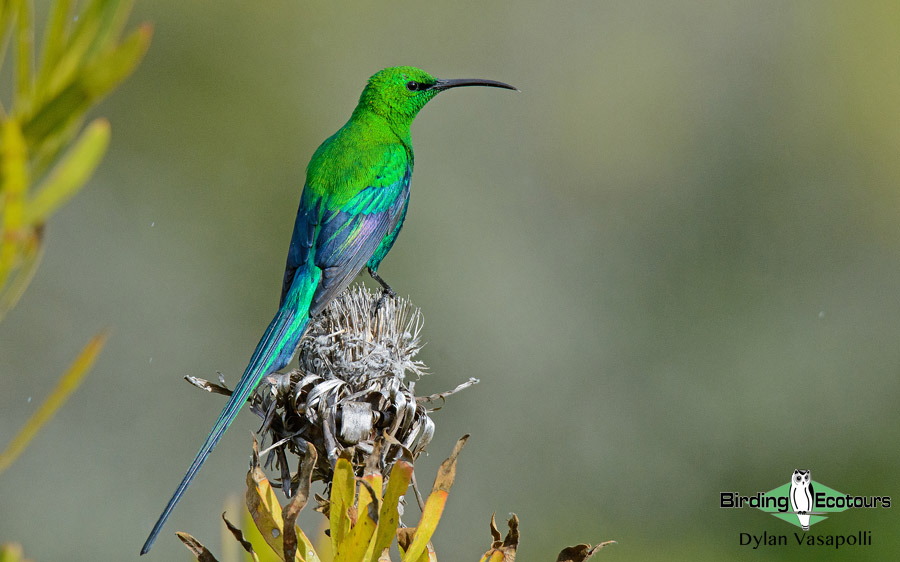
We will then head around the corner to Betty’s Bay to explore the beautiful Harold Porter National Botanical Garden. Here the birds are often very approachable, allowing for great photographic opportunities. Sunbirds abound in these gardens, including Amethyst, Southern Double-collared, Orange-breasted, and Malachite Sunbirds. We should also become acquainted with Southern Boubou, Olive Thrush, Cape Robin-Chat, and Fiscal Flycatcher.
After enjoying lunch in the gardens, we will head to the rocky coast at Stony Point to visit an African Penguin colony, however, we will also be targeting Bank Cormorant here. Four species of marine cormorant breed at Stony Point (Bank, Crowned, Cape, and White-breasted Cormorants) and often give you a chance to photograph them as they fly back and forth feeding chicks or constructing nests.
If time allows, we will pop into Strandfontein Bird Sanctuary on our way back to Cape Town. This area represents the best wetland birding around Cape Town, and we will aim to photograph flying Lesser and Greater Flamingos in the golden afternoon light with Table Mountain and the Hottentots Holland Mountains serving as beautiful backdrops. Other waterbirds to be enjoyed here include South African Shelduck, Maccoa Duck, Southern Pochard, Black-necked Grebe, and many other common aquatic species. If we run out of time this afternoon, we can head back here the following day.
Overnight: Fernwood Manor, Newlands (or similar)
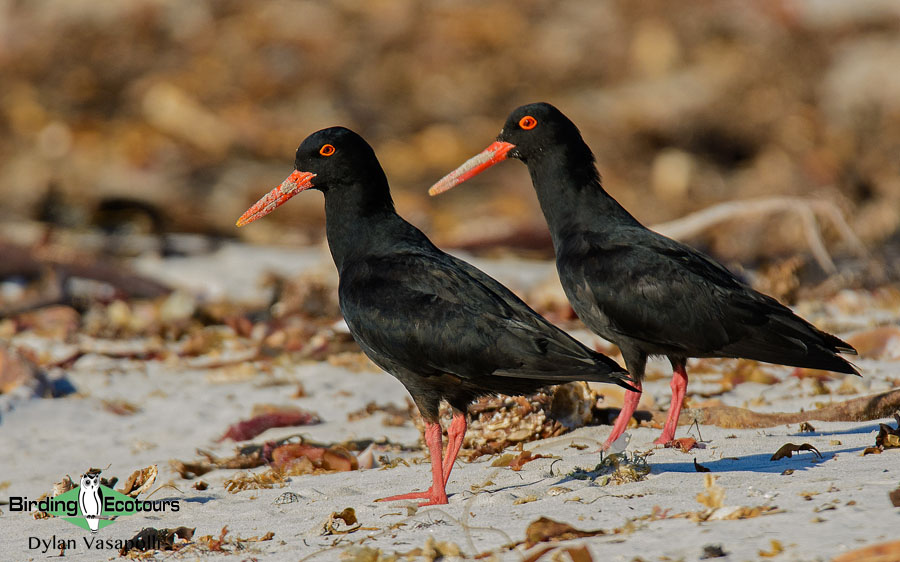
Day 10. Cape Peninsula
Today will be spent birding and photographing on the Cape Peninsula. We will start the morning by heading south to the Cape of Good Hope Nature Reserve, where we will visit the most southwesterly point of the African continent. The views of False Bay and the Atlantic Ocean are truly impressive, and from here we can also enjoy Cape Cormorants nesting on the cliffs below us, along with the odd Peregrine Falcon. We may do a sea watch for various seabird species from the cliffs, when we should be able to pick out distant Cape Gannet, White-chinned Petrel, Sooty Shearwater, and perhaps an albatross or two! African Oystercatcher is usually present as well. Around the reserve we will also keep a lookout for Cape Grassbird, Cape Siskin, Cape Bunting, and Fiscal Flycatcher. Common Eland, Africa’s largest antelope, should be encountered during our time in the reserve as well as several Common Ostrich.
In the afternoon we will head to Kirstenbosch National Botanical Garden, where we will wander around the picturesque gardens with Table Mountain serving as a stunning backdrop. In the gardens we should find African Olive Pigeon, Cape Bulbul, African Dusky Flycatcher, Cape Sugarbird, Orange-breasted and Malachite Sunbirds, Cape, Brimstone, and Forest Canaries, and the tiny and colorful Swee Waxbill.
Overnight: Fernwood Manor, Newlands (or similar).
Days 11 – 15. Kruger National Park
Depending on flight times this morning, we may have time for some last-minute forest birding, targeting anything we may have missed over the last couple of days. Cape Town International Airport is only a 20-minute drive from our accommodation, from where we will take a flight to the Kruger Mpumalanga International Airport for the Kruger National Park leg of this trip.
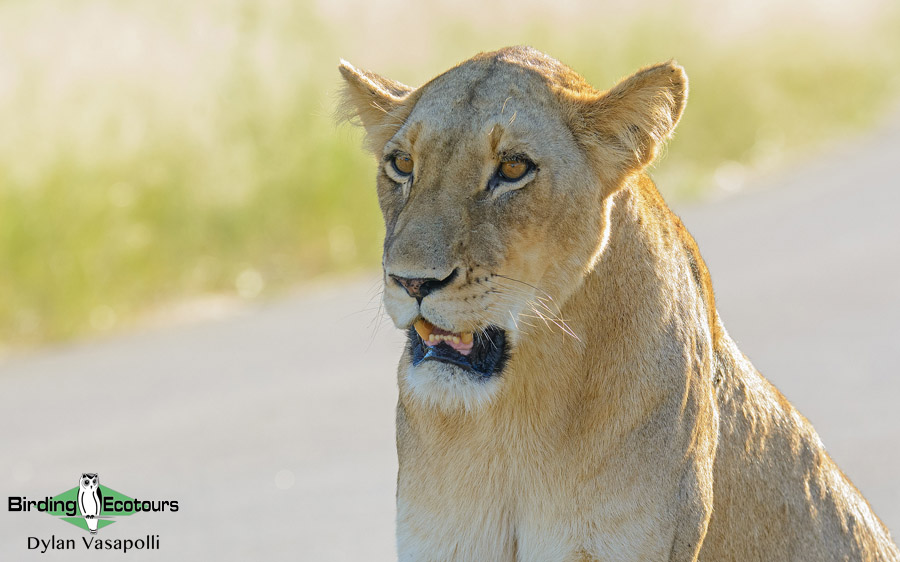
Here we will spend five days/four nights photographing Africa’s “Big Five” as well as a host of other animals – expect such charismatic species as African Elephant, Giraffe, Hippopotamus, Plains Zebra, Common Wildebeest, Impala and Nile Crocodile. We also have good chances for some of Africa’s most prized predators such as Lion and Leopard, along with Spotted Hyaena, and other animals such as Banded Mongoose and Vervet Monkey. Of course, the birds are also extremely important, and we will not forget about them whilst in Kruger – as many of them are extremely photogenic. Some of the big and obvious species we will look for include Kori Bustard, Martial Eagle, Bateleur, Saddle-billed Stork, Verreaux’s Eagle-Owl, Southern Ground Hornbill, and Lappet-faced Vulture, while the smaller, more colorful species include Brown-headed Parrot, Greater Blue-eared Starling, Lilac-breasted Roller, Grey-headed Bushshrike, White-browed Robin-Chat, Scarlet-chested Sunbird, Blue Waxbill, Golden-breasted Bunting and a host of kingfishers, barbets, bee-eaters, hornbills, and weavers – and so much more. The above-mentioned species are just a small sampling of some of the exciting possibilities that await us in Kruger – this truly is an incredibly diverse area, with over 500 bird species and 100 mammal species recorded from within the reserve.
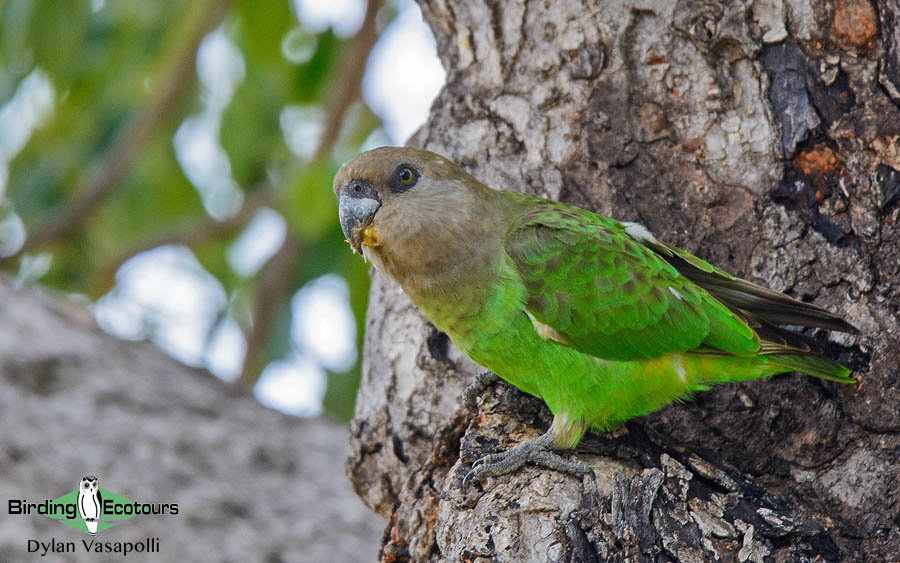
After four nights in this incredible birding and wildlife destination, we will have to bid the Kruger National Park, and this tour, farewell. This tour will end at the Kruger Mpumalanga International Airport on Day 15.
Overnight: Rest camps, Kruger National Park.
Please note that the itinerary cannot be guaranteed as it is only a rough guide and can be changed (usually slightly) due to factors such as availability of accommodation, updated information on the state of accommodation, roads, or birding sites, the discretion of the guides and other factors. In addition, we sometimes have to use a different international guide from the one advertised due to tour scheduling.
Download ItineraryWestern Cape and Subtropical South Africa Trip report March 2017
This is a sample trip report. Please email us ([email protected]) for more trip reports from this destination.
SOUTH AFRICA BIRDING AND PHOTO TOUR – CAPE TO KRUGER NATIONAL PARK
TOUR-SPECIFIC INFORMATION
GENERAL INFORMATION ABOUT SOUTH AFRICA CAN BE READ HERE
TOUR OUTLINE
This 15-day tour is centered on offering fantastic photographic opportunities of South Africa’s most iconic birds and mammals. The tour starts in the picturesque Garden Route, complete with lush, forested hills set between dramatic mountains and serene beaches. We then venture west onto the rolling flats of the Agulhas Plain; a scene of agricultural land intermingled with areas of renosterveld fynbos. One such patch is found at De Hoop Nature Reserve, where we will base ourselves for two nights. From here, we move north, away from the coast, crossing over the stately Cape Fold Mountains into the arid desert region known as the Tankwa Karoo, which should provide us with stark landscapes and semi-desert specials. Journeying west, we cross back over another section of the Cape Fold Mountains and head towards the west coast to the holiday town of Langebaan, situated on the idyllic and bird-rich Langebaan Lagoon. The final region of this first segment of the tour is the beautiful city of Cape Town, in the southwest corner of South Africa. Here, we base ourselves for a few days while exploring the scenic mountainous and coastal regions beyond the city. This concludes the Cape leg of this tour, after which we will fly to the northeast of South Africa for a totally different wildlife experience.
After landing from our Cape Town flights, we spend five days in the world-renowned Kruger National Park enjoying the full safari experience. Over the five days spent in the park, we will go on game drives, see lots of exciting birdlife and hopefully acquaint ourselves with the Big Five, amongst the many other large mammals and tropical bird species found in the park. The tour will then end at Nelspruit/Mbombela from where we will fly out.
PACE OF TOUR
Even though this tour is quite busy, the pace is generally slower than our comparable tours of similar length, due to the photographic-oriented focus (rather than concentrating on accumulating high species numbers). That being said, the first part of the tour around the Garden Route and Cape Town covers lots of ground, with much driving, and we will have mostly full days. The Kruger leg of the tour should be more relaxed as we will return to the accommodation at midday between our morning and afternoon drives into the park. We will have early mornings most days (sunrise will be between 5:30 and 6:00).
Breakfast packs will be taken out most mornings for a picnic breakfast in the field, to make the most of peak birding activity at dawn. These are simple but perfectly adequate, and there may also be the opportunity for us to have a sit-down breakfast, on occasion. This would also apply for lunches. Dinners will involve sit-down meals at our accommodation or at nearby restaurants.
Night birding may also be done on this tour, but, as with all our tours, these are optional and you are welcome to opt out of any nocturnal excursions that may be offered. If interested, you can book a guided night drive in Kruger National Park upon our arrival at the rest camps, however, these would be at your own expense.
To re-emphasize, this is a photography-centered tour, and we therefore will spend longer periods observing and photographing animals and birds, than we normally do on our other regular birding tours.
WALKING AND STYLE OF BIRDING
This tour does not involve intense physical exertion and does not include any long or strenuous hikes. For the first part, the Garden Route to Cape Town leg of the tour, birding will either be done from the vehicle or on short walks. These walks should not be longer than two miles (3.2 kilometers) and will not be over steep terrain. It is worth mentioning that the walking track at Rooi Els where we look for Cape Rockjumpers is quite rocky and uneven.
In Kruger, we will mostly bird from the vehicle, as we are confined to our vehicle outside of certain designated areas (like hides/blinds, camps and picnic sites). We are restricted to our vehicles within the park, as it contains potentially dangerous wildlife such as Lions and African Elephants. We may also go for walks around the rest camps, though these are easy and short, typically under one mile (1.6 kilometers).
LENGTH OF DRIVES
Several of the days in the first part of the tour, from the Garden Route to Cape Town, will mostly be travel days with the odd birding stop en route to our next destination. Some of these longer transfer days include from the Garden Route to De Hoop Nature Reserve, De Hoop Nature Reserve to the Tankwa Karoo and the Tankwa Karoo to Langebaan. On these transfer days, we’ll likely leave in the morning (e.g. 8 am) and spend the whole day traveling and birding en route to our overnight accommodation, likely arriving in the late afternoon (e.g. 5 pm).
We do not cover larger distances during the Kruger National Park leg of this trip, although will be mostly vehicle based while in the park.
SAFETY
Being away from urban centers for most of the tour, we do not expect crime to be a problem. During our time in Cape Town and other cities, we will only visit areas that we deem safe, and won’t be spending much time within the city itself. However, as is the case in any big city, it is always best to be aware and vigilant of yourself and your belongings. We also recommend that you do not leave your personal belongings and valuables in the unattended vehicle, particularly in larger towns and cities, and when stopping in towns en route to your next destination. If you are ever in doubt about the safety of an area, please check with your tour leader.
While we are in the Kruger National Park, we will mostly be limited to the vehicle, as it is a big-game nature reserve, with potentially dangerous animals. Here, we will be under the supervision of park rangers, who will instruct us on where we may alight from our vehicle (e.g. at picnic sites etc.) and it is of utmost importance to adhere to their instruction while in the park.
HEALTH, PESTS AND DANGEROUS ANIMALS
When birding on foot, we advise wearing long pants and using tick repellant spray on your legs, socks and shoes as there could be ticks around. Ticks in South Africa fortunately do not carry Lyme Disease, but a bite may lead to tick-bite fever. This is, however, a far less threatening disease with generally no major, long-term consequences.
We also advise not touching or petting any stray dogs in rural areas on the off chance that they are carrying rabies; not a common disease in South Africa but it is still around.
*Note that dangerous animals (like Lion, Elephants) and venomous snakes and scorpions etc., are all possible, and these are all discussed in greater detail under the “South Africa General Information” document.
Malaria
We strongly recommend taking anti-malaria medication for the Kruger National Park section of this tour. Taking place in January, this tour falls within the wet season for the Kruger region, so the risk of getting malaria is higher than during the dry season. Any one of the following three drugs is highly effective (albeit not 100 %, due to resistant strains of malaria) as protection against malaria:
Malarone (atovaquone/proguanil),
Doxycyxline, and
Larium (mefloquine).
In addition to medication, the following measures can also be taken:
- Using mosquito repellant spray.
- Wearing long-sleeved shirts and trousers when out in the field, particularly near stagnant water.
- Wearing long sleeves at night, when malaria (Anopheles) mosquitos are most active.
If you still manage to contract malaria, despite taking these precautions, it can generally be easily treated soon after symptoms are detected, with a prophylactic of your choice. Flu-like symptoms developing within weeks of the tour ending are indicative that you may have contracted malaria.
TRANSPORTATION
A 14-seater minibus will be the main tour vehicle which will ensure everybody has access to a window seat, every day of the tour. While in Kruger we will mostly be using an open-top safari vehicle, driven by game rangers. As with our other birding tours, we will use a seat rotation policy within the vehicle which will be explained to you by your tour leader at the start of the tour.
We will provide airport transfers to participants on the first and final days of tour, which are included in the tour cost. Should you arrive in South Africa earlier than that or prolong your stay in South Africa after the tour, those transfers would be at your own expense. We will, however, help arrange transfers wherever they may be needed.
DOMESTIC FLIGHTS
At the conclusion of the Cape Town leg of the tour, we will fly from Cape Town airport to the Kruger Mpumalanga International Airport (in Mbombela/Nelspruit), to commence with the Kruger portion of the trip. Kindly speak to the Birding Ecotours office to liaise about these logistics before booking any flights.
ACCOMMODATION
We will stay in comfortable lodges, guesthouses and rest camps that are of good to excellent quality. Our accommodation in Kruger National Park is more basic as it is government-run, but still comfortable. Staying inside the park allows us to be out at optimal birding time, first thing in the morning. The lodge we make use of in the Tankwa Karoo has its rooms (simple and rustic chalets/farmhouses) largely spread out. There are limited options in this region, and the homely nature of this lodge, combined with unparalleled access to the birds of the area make this an essential choice.
An important note is that South African buildings are not heated as effectively as they are in Europe or North America (and often not heated at all), so we advise you to bring adequate warm clothing, particularly for sleeping.
ELECTRICITY
Lighting in rooms tends to be low wattage (especially in Tankwa Karoo and Kruger National Park), so you might like to bring a good quality torch/flashlight if you like reading in bed!
It is good practice to bring international adapters, as many establishments are changing their plug outlets to better align with international clients, and this is an aspect we do not have direct control over.
WEATHER
This tour falls during mid-summer and our crossing regions of differing climes may add to the variability of weather. The Garden Route/Cape Town part should mostly be hot during the day (averaging around 79°F (26°C)) while being relatively cool at night (averaging around 62°F (16°C)), with the likelihood of strong winds in the afternoons. It would also be worth remembering to bring a scarf or buff, as it can get quite windy in the Cape. In the Karoo, this wind can kick up a lot of dust, making breathing uncomfortable, so you may want to consider bring along a buff/scarf.
The Karoo, being a semi-desert, should be hotter, drier, and a bit more extreme in temperature, often reaching 86°F (30°C) in the day and down to 50°F (10°C) at night.
Kruger National Park should also be hot (routinely reaching 95°F (35°C)) with additional humidity, and the likelihood of thunderstorms and rainfall. Therefore, we recommend mostly packing for warm weather, however, cold and wet weather is a possibility too. It is good practice to bring a raincoat/poncho for this part of the tour.
WHAT TO BRING: CLOTHING AND OTHER ITEMS
Please see our blog on ‘What to bring on a birding tour’ which will help you pack for this Cape to Kruger Birding and Photography tour.
‘My sister and I used one of our 2 and a half days in Cape Town to do a birding tour of the Peninsula including the Cape of Good Hope. I had great communication with our guide, Dom, before the tour and he picked us up right on time at our hotel. It was an excellent day. Dom is very knowledgeable and good company. It turned out he was at Magee Marsh in Ohio the same time I was this year! The weather was glorious and we got to see lots of SA endemics plus a Humpback Whale and a lifer sewage pond! I would recommend Birding Ecotours and Dom Rollinson to anyone birding in South Africa.’
Jean
‘Birding Ecotours company and SA office staff
I can highly recommend booking a trip through Birding Ecotours South Africa. The Birding Ecotours staff is professional, the e-mail responses fast and all questions receive detail replies. Chris Lotz of Birding Ecotours forwarded excellent advice to me on how to start world birding, which countries to visit in order to find a high number of birds over a short period and which bird book(s) to use for a country. Birding Ecotours’ newsletters provide further information on upcoming trips, details on areas (e.g. East African birding), on target birds per trip, as well as regarding birding books available for countries or areas. Trip reports (forwarded upon request) allow one to mentally prepare regarding number of possible birds, endemics per country and difficulty or travel time of a trip. The Birding Ecotours’ Facebook postings include snippets from current trips with photos as well as spaces available on future trips. The single supplement for Birding Ecotours’ trips is in most cases lower than other tour companies, which makes for safe as well as affordable travelling.’
Lisl
